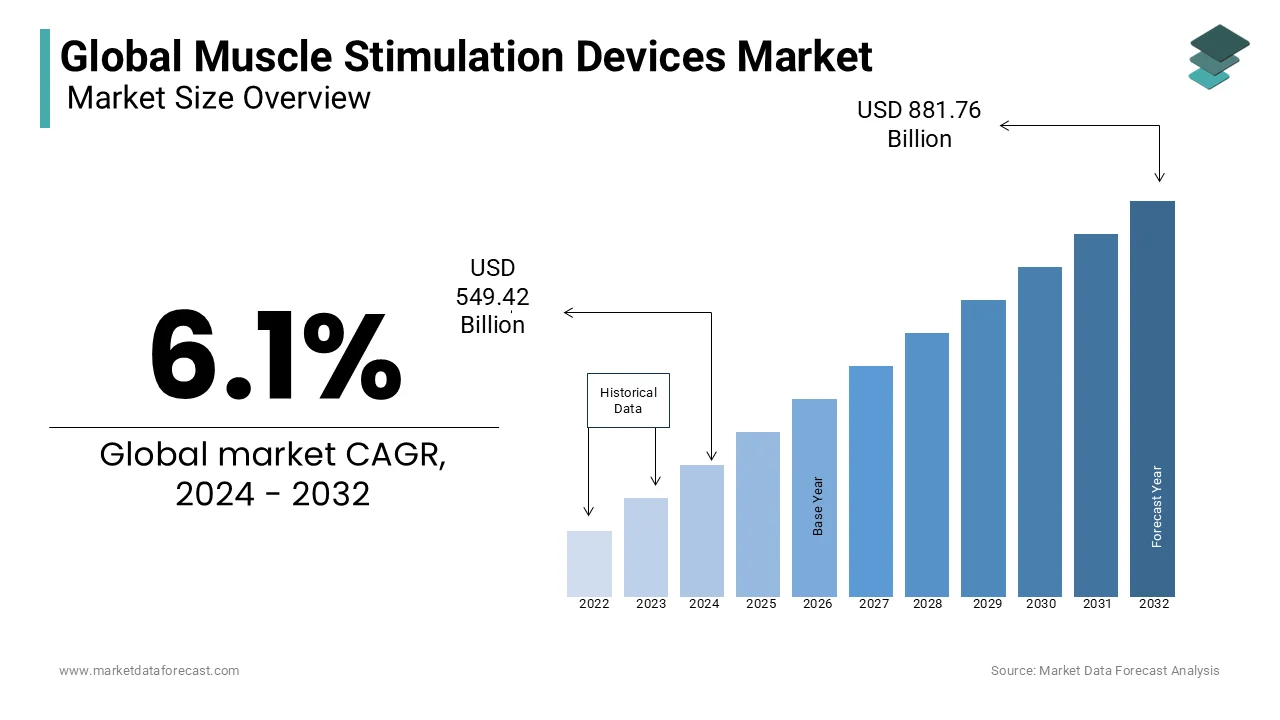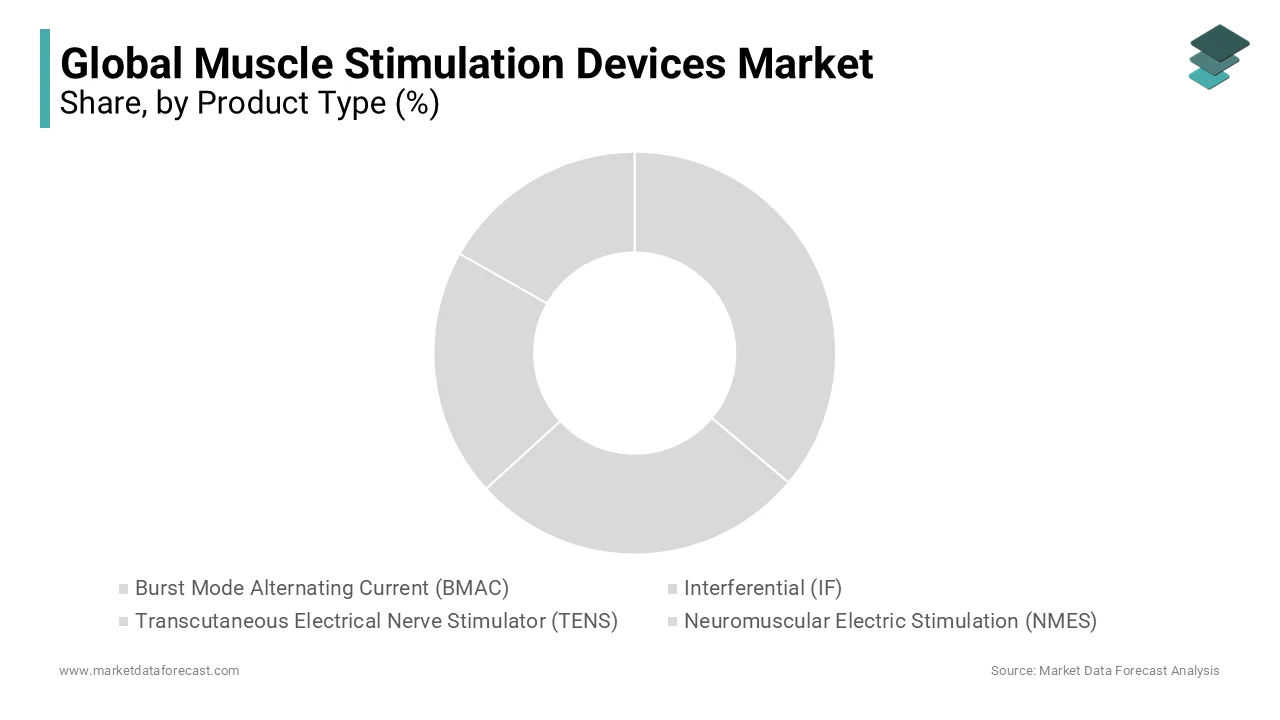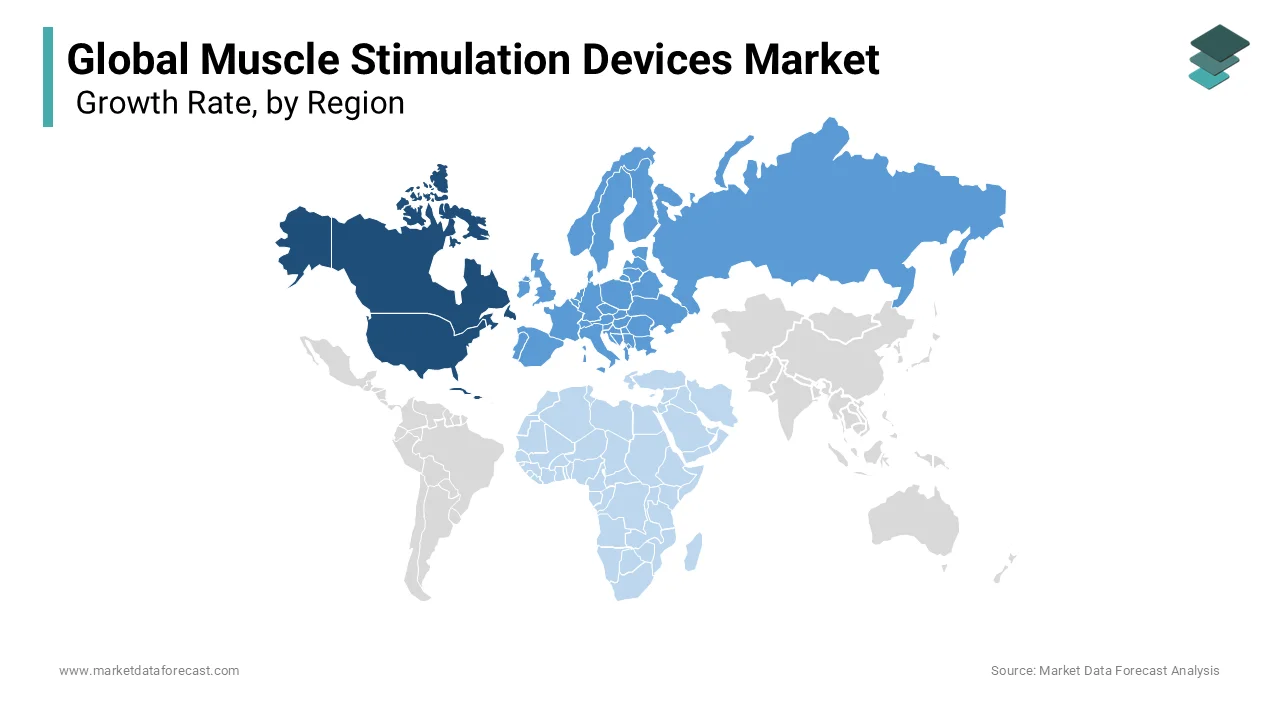Global Muscle Stimulation Devices Market Size, Share, Trends & Growth Analysis Report – Segmented By Product Type (Burst Mode Alternating Current (BMAC), Interferential (IF), Transcutaneous Electrical Nerve Stimulator (TENS) and Neuromuscular Electric Stimulation (NMES)), Application, End-User, & Region - Industry Forecast From (2025 to 2033)
Global Muscle Stimulation Devices Market Size
In 2024,the global muscle stimulation devices market was valued at USD 549.42 million and it is expected to reach USD 936.14 million by 2033 from USD 582.93 million in 2025, growing at a CAGR of 6.1 % during the forecast period.

Muscle stimulation devices help people who are suffering from weak or diseased muscles. Doctors use these devices to treat patients suffering from pain due to injuries. These devices heal the injury by improving the blood flow as the muscle fibers or nerves get stimulated with the electric currents. Muscle stimulation devices got approval from the Food and Drug Administration for chronic pain by relaxing muscle spasms, retraining muscles, and preventing muscle loss. According to the National Library of Medicine, chronic pain affects more than one-quarter of the citizens in the US. Negligence in managing chronic pain may lead to significant morbidity and mortality. One in ten people is seeking medical advice related to chronic pain, and the number is expected to increase in the coming years. Muscle stimulation devices help ease the chronic symptoms due to pain and improve the quality of life of the patients. Therefore, medical professionals' demand to use muscle stimulation devices is predominantly increasing randomly. Advances in the healthcare industry are achieving targets to overcome all the challenges occurring with traditional devices, which is a great factor for the market share to grow during the forecast period.
MARKET DRIVERS
The growing prevalence of musculoskeletal disorders and the increasing aging population primarily drive the global muscle stimulation devices market growth.
The influx of investments by governments for developing novel and innovative medical devices also plays an essential role in the growth of the global market. Rapid urbanization and growing awareness among people regarding fitness and health, coupled with the emergence of novel and innovative smart devices leading to the rise in demand and adoption rate of these devices, further expand the growth of the muscle stimulation devices market. Increasing economies of the developed and developing countries, advancements in the digital market, and the emergence of various technically advanced devices such as Power Dot and Bright Mix by key players are also actively propelling the growth of the global muscle stimulation devices market. The rising prevalence of cancer and arthritis is another major factor that catalyzes the growth of the muscle stimulation devices market.
In addition, muscle stimulation devices are adopted most in physiotherapy clinics, another major factor fuelling the growth of the global muscle stimulation devices market. The main goal of e-stim therapy is to simulate voluntary contraction and relax a muscle repeatedly by strengthening and repairing tissues that have been atrophied, shortened, or weakened due to injury. Increasing focus by various public and private healthcare bodies to provide advanced and better healthcare services is also a factor that boosts the growth rate of this market. In addition, emerging economic conditions, rising healthcare expenditure, and improving the standard of living are other factors that mount the growth of the muscle stimulation devices market at a global level.
MARKET RESTRAINTS
The significant factors restraining the growth of the global muscle stimulation devices market are the high costs associated with physiotherapy sessions leading to the low adoption rate of the devices, stringent rules, and policies by various governments in Europe, Canada, and the US market their adoption. Furthermore, the high cost of muscle stimulators making customers opt for cheaper alternative therapies like acupuncture, and the need for continuous supervision of medical experts to avoid skin irritation, shocks, bruising, and burns is another major challenge for the growth of the muscle stimulation devices market. In addition, the time-consuming approval procedures are leading to delays in launching advanced devices into the market, further slowing down the market's growth.
REPORT COVERAGE
|
REPORT METRIC |
DETAILS |
|
Market Size Available |
2024 to 2033 |
|
Base Year |
2024 |
|
Forecast Period |
2025 to 2033 |
|
CAGR |
6.1 % |
|
Segments Covered |
By Product Type, Application, End-User, and Region |
|
Various Analyses Covered |
Global, Regional & Country Level Analysis, Segment-Level Analysis, Drivers, Restraints, Opportunities, Challenges; PESTLE Analysis; Porter's Five Forces Analysis, Competitive Landscape, Analyst Overview of Investment Opportunities |
|
Regions Covered |
North America, Europe, Asia Pacific, Latin America, Middle East & Africa |
|
Market Leaders Profiled |
DJO Global, Inc., Zynex, Inc., NeuroMetrix, Inc., RS Medical, Inc., and Omron Corp |
SEGMENTAL ANALYSIS
By Product Type Insights
The TENS product category captures a 71.5% market share based on product type and is estimated to reduce over the above-mentioned forecast. TENS is another form of e-stim therapy that primarily blocks pain signals in the brain and has been used by doctors and physical therapists regularly since the 1960s. For different purposes like relaxation, circulation, and blocking pain, TENS therapy provides electrical stimulation at different wavelengths, which can also be done at home.

As mentioned earlier, the NMES segment is anticipated to grow over the forecast. NMES uses a device for sending electrical impulses to nerves causing muscles to contract, increasing strength, increasing blood circulation and range of motion, and decreasing muscle spasms.
By Application Insights
The pain management segment is anticipated to grow considerably compared to the other categories during the forecast, as mentioned above. The pulses from the stimulation device reach the muscles allowing them to contract, get directed to the nervous system, and prevent the transmission of pain signals from reaching the brain and spinal cord. Therefore, these pulses not only stimulate the body to produce more natural pain-relieving chemicals called endorphins but also have devastating consequences for paralytic persons and significant economic consequences for society.
The movement disorder management segment is also foreseen to hold a significant market share. These persons can regain some mobility using Functional Electrical Stimulation (FES), which could boost their independence and general health and well-being. FES works by electrically stimulating paralyzed muscles.
By End User Insights
The physiotherapy clinics segment is anticipated to command the overall muscle stimulation devices market over the forecast, as mentioned above period. The focal point of physiotherapy clinics is providing clinical reimbursement granted to patients visiting for exciting treatments, and accessibility of these treatments, along with a reasonable cost in physiotherapy centers, is expected to drive the development of the market.
The home care segment is also expected to hold a significant market share. Without the direct supervision of a medical professional, using home electrical stimulation to treat wounds is regarded as untested or experimental.
REGIONAL ANALYSIS
North America is estimated to command the global muscle stimulation devices market among all the regions during the forecast period, followed by Western Europe, due to the significant presence of international players in these regions conjoined with a countless number of products lined up for FDA clearance. The United States is expected to account for the highest market share in this region due to several cases related to musculoskeletal disorders. The Canadian muscle stimulation devices market will have a healthy CAGR during the forecast period.

Europe is another promising regional market globally and is expected to register a healthy growth rate during the forecast period. High discretionary income and growing awareness among patients, increasing the acquisition of technological advancements, are majorly fuelling the market in this region. The UK is expected to lead the European market between 2023 to 2029.
The Asia-Pacific region is anticipated to grow at the fastest growth rate over the analysis period. Increasing awareness in public regarding health and fitness, the growing patient population related to various muscle injuries, and advancing healthcare infrastructure are bolstering the market's demand. China has a prominent market for muscle stimulation devices, driven by growth in constant ailments, the high occurrence rate of road accidents, and many disabled people, boosting market growth over the forecast period. In India, the growth is due to increased expendable income in existing economies fuel growth.
Latin America is expected to showcase a steady CAGR during the forecast period due to the increasing number of people who opt for these devices, increasing healthcare expenditure, increasing government initiatives for the market, and growing intelligent devices for maintaining health.
The market in the Middle East & Africa has the most negligible share in the muscle stimulation devices market over the analysis period due to slow and poor economic and political conditions. Countries like Saudi Arabia and UAE are leading the Gulf nations in this region.
KEY MARKET PLAYERS
Some notable companies in the global muscle stimulation devices market profiled in this report are DJO Global, Inc., Zynex, Inc., NeuroMetrix, Inc., RS Medical, Inc., and Omron Corp.
RECENT HAPPENINGS IN THIS MARKET
- In November 2022, an emerging leader in neurological rehabilitation, MyndTec Inc., launched MyndStepTM to seize opportunities in medical devices, reinforcing its commitment to providing rehabilitation centers, clinics, and physicians with innovative products. The main focus is improving patient care and quality of life by providing ankle dorsiflexion in people who experience foot drop due to upper motor neuron injury.
- In October 2022, Pulse Biosciences, Inc., a new bioelectrical medicine company, announced positive clinical data for an FDA-approved research device for the CellFX System with Nano-Pulse Stimulation™ (NPS™) technology, resulting in effective and cosmetically acceptable treatment, giving a high degree of confidence in NPS technology and a possible alternative for many types of BCC lesions.
- DJO Global Inc. released a product called Triit Knee brace in 2017. The product is majorly applied for relieving pain in patients affected with degenerative joint diseases. The device is integrated with Exos tech, Web tech, and Boa tech. With this product launch, the company has witnessed significant demand.
- In 2017, iReliev Company launched a product called PlayMaker for muscle stimulation. This wearable wireless device treats chronic and acute pain symptoms such as arthritis and assists patients in following their daily routines and activities. The device consists of 14 preset modes of therapy for personalized treatments, and more treatment modes can be added with the help of receivers.
MARKET SEGMENTATION
This report on the global muscle stimulation devices market has been segmented and sub-segmented based on the product type, application, end-user, and region.
By Product Type
- Burst Mode Alternating Current (BMAC)
- Interferential (IF)
- Transcutaneous Electrical Nerve Stimulator (TENS)
- Neuromuscular Electric Stimulation (NMES)
By Application
- Musculoskeletal Disorder Management
- Pain Management
- Neurological
- Movement Disorder Management
By End User
- Physiotherapy Clinics
- Home Care
- Hospitals
- Sports Clinics
By Region
- North America
- Europe
- Asia Pacific
- Latin America
- Middle East and Africa
Frequently Asked Questions
Which region is growing the fastest in the global muscle stimulation devices?
Geographically, the North American muscle stimulation devices market accounted for the largest share of the global market in 2025.
At What CAGR, the global muscle stimulation devices market is expected to grow from 2024 to 2033?
The global muscle stimulation devices market is estimated to grow at a CAGR of 6.10% from 2024 to 2033.
What was the size of the muscle stimulation devices market worldwide in 2025?
The global muscle stimulation devices market size was valued at USD 582.93 million in 2025.
Related Reports
Access the study in MULTIPLE FORMATS
Purchase options starting from $ 2500
Didn’t find what you’re looking for?
TALK TO OUR ANALYST TEAM
Need something within your budget?
NO WORRIES! WE GOT YOU COVERED!
Call us on: +1 888 702 9696 (U.S Toll Free)
Write to us: [email protected]
